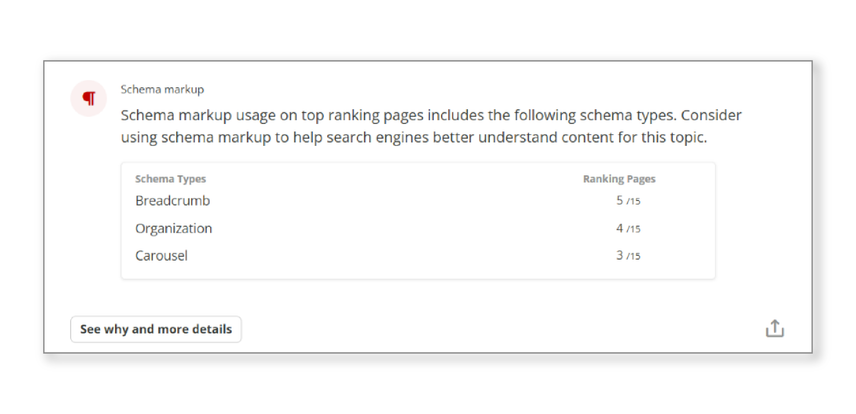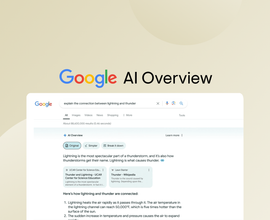September & October 2024 SEO Industry Updates
- Industry News
- By multiple authors
- 7 minutes read
Conductor is back with coverage of recent industry news for SEO and website optimization. Topics covered include; Ads in Google AI Overviews, updates to URL best practice documentation from Google, Google proposes a new shipping structured data type, and results from testing out SearchGPT.
Google AI Overview ads launch on mobile in U.S.
The what
As reported by Search Engine Land, Google is launching AI-powered ad overviews for mobile users in the U.S. This feature summarizes key information from advertisers' websites when users click on ads, providing a brief overview and additional information that can help users make informed decisions without navigating away from their search results. However, Google is not offering specific reporting for these AI overview ads, meaning advertisers won’t have a detailed view of how these overviews directly impact user behavior or conversions.
The why
This update is important because it aims to improve user engagement with ads by offering immediate, digestible information, making the decision-making process more seamless for mobile users. For advertisers, this could increase the chances of conversion. However, the lack of specific reporting makes it a pivotal time for paid and SEO teams to align closely, ensuring they are tracking and actioning insights holistically. Collaborating on shared metrics and strategies will be crucial to maximizing the impact of these AI Overview ads on broader business goals.
For Conductor customers
Track Performance: While Google's reporting lacks granularity, Conductor's AIO data will help you monitor how often your content appears within these critical AI Overview spaces (Desktop only). Use Result Types , Market Share , and Keywords reports to monitor you AI Overview visibility and understand the types of keywords triggering this result.
For everyone else
Actionable Insights: Use AIO data to inform your overall paid strategy, optimizing your organic presence and shopping campaigns to align with high-traffic keywords that drive results.
Cross-Team Collaboration: Both your SEO and Paid teams will benefit from monitoring this new ad format to adjust campaign strategies, ensuring you're fully capitalizing on this prime real estate in search results.
Google proposed a new shipping structured data type
The what
Google has proposed a new shipping structured data type called “ShippingService” on the Schema.org GitHub instance to support a richer representation of shipping details (such as delivery cost and speed) and to make this type of data explicit. Schema.org is a markup standard that is useful for helping Google and other search engines understand what’s on your website. The proposal also suggests adding a sitewide Organization structured data type so that merchants can use structured data more efficiently with an ability to present redundant structured data related to shipping in one place. If this proposal is accepted some fields in “OfferShippingDetails ” would move to the new “ShippingService”.
The why
The proposal states search experiences and other consuming systems could be improved by using this type of schema markup. This markup would enable customers to get more detailed information that will likely show up in new shopping-related rich results and enhance the experience of shopping on Google. This proposed new “ShippingService” structured data type would group shipping details like delivery locations, time, weight and size limits, and shipping rate.
For Conductor customers
Conductor Intelligence customers can use platform sections like Content Guidance to research common schema types used by top-ranking pages for any given keyword. This information can help you and your team understand schema types that may be worth including on your pages to compete for coveted universal result types.

Conductor Website Monitoring customers can create segments to organize and better understand how frequently and what types of schema are currently live on your website. There is also a specific issue type available to review if schema elements on your website are implemented correctly and if they have a valid JSON-LD object.

For everyone else
Schema.org has a free schema validator tool that can be used for any page on your website or any competitor's page. Google also offers a free rich results testing tool that will test any publicly accessible page to see what rich results can be generated based on the structured data a page contains. You should review the different types of structured data your website currently utilizes vs what types of schema your biggest competitors are using on their pages to understand if there’s a gap.
Core Web Vitals documentation updated
The what
Search Engine Journal reported on recent updates made to Core Web Vitals documentation on INP . INP (Interaction to Next Paint) officially replaced FID (First Input Delay) as a Core Web Vital metric back in March this year. INP is a more comprehensive metric that evaluates the responsiveness of a page over time and measures how long it takes for the page to respond to interactions, such as clicks or taps. FID measured the responsiveness of a page but came with known limitations when it came to measuring anything after a user's first interaction with a page.
Search Engine Journal shared that the main change to the documentation was to, “provide an explanation for the speed performance thresholds that show poor, needs improvement and good.” Google states, “To ensure you're delivering user experiences with good responsiveness, a good threshold to measure is the 75th percentile of page loads recorded in the field, segmented across mobile and desktop devices”.
The why
Website optimization teams looking to make meaningful changes to their INP scores should review the latest speed performance thresholds for INP. Instead of aiming at an ambiguous target, teams can focus their efforts on development practices and updates that provide users with good experiences based on more clear guidelines. Teams optimizing for performance by minimizing presentation delay or optimizing callback events now know more about the scores necessary to achieve good responsiveness. The updated INP documentation is accessible on Web.dev and provides details on how Google defines a good INP score .
- An INP below or at 200 milliseconds means a page has good responsiveness.
- An INP above 200 milliseconds and below or at 500 milliseconds means a page's responsiveness needs improvement.
- An INP above 500 milliseconds means a page has poor responsiveness.
For Conductor customers
Conductor customers can evaluate their website’s technical performance for any page using the Conductor Chrome extension . Conductor Website Monitoring customers can measure Core Web Vitals metrics like INP through the platform. Users can reference their scores for specific segments of their site through the dashboard view.

You can enable all three Core Web Vitals metrics within your “pages” section to evaluate how well different URLs across your website perform for each metric. If you’re interested in prioritizing particular pages across your website that are underperforming for INP and other Core Web Vitals metrics, consider creating specific segments for performance.
For everyone else
You can learn how to optimize for INP through free guides available from Google on Web.dev. Their official guide even provides you with an on-page test where you can evaluate your knowledge of INP to ensure your understanding is accurate and up to date. You can also reference the Conductor Academy article that provides additional details on the factors that affect website performance.
Stay Tuned
The world of search is changing rapidly, don’t get left behind! Conductor has a plethora of upcoming virtual events to help you stay on top of the most recent industry changes while teaching you how to get the most out of your organic marketing programs. Whether you’re interested in live training sessions or on-demand virtual events, Conductor will help keep you up to date on the latest in SEO and website optimization.








